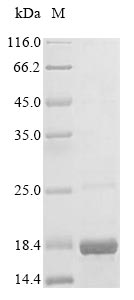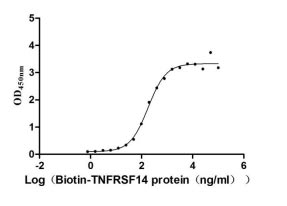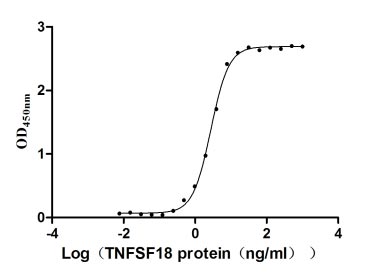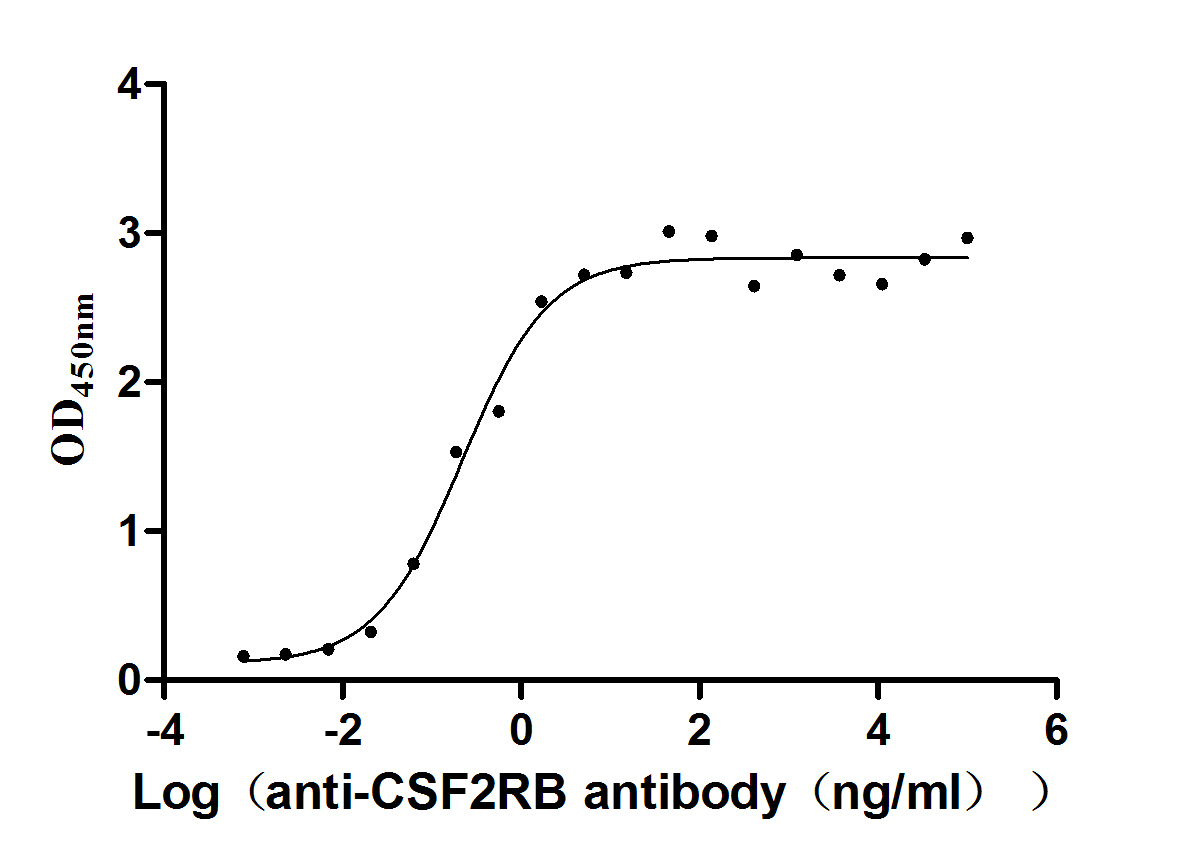Recombinant Human SH3 and PX domain-containing protein 2A (SH3PXD2A), partial
In Stock-
中文名称:人SH3PXD2A重组蛋白
-
货号:CSB-EP735983HU
-
规格:¥1836
-
图片:
-
其他:
产品详情
-
纯度:Greater than 90% as determined by SDS-PAGE.
-
基因名:SH3PXD2A
-
Uniprot No.:
-
别名:Adapter protein TKS5; Five SH3 domain-containing protein; SH3 and PX domain-containing protein 2A; SH3 multiple domains protein 1; Sh3md1; Sh3pxd2a; SPD2A_HUMAN; TKs5; Tyrosine kinase substrate with five SH3 domains
-
种属:Homo sapiens (Human)
-
蛋白长度:Partial
-
来源:E.coli
-
分子量:14.0 kDa
-
表达区域:902-986aa
-
氨基酸序列PDPSGKELDTVPAKGRQNEGKSDSLEKIERRVQALNTVNQSKKATPPIPSKPPGGFGKTSGTPAVKMRNGVRQVAVRPQSVFVSP
Note: The complete sequence including tag sequence, target protein sequence and linker sequence could be provided upon request. -
蛋白标签:N-terminal 10xHis-tagged and C-terminal Myc-tagged
-
产品提供形式:Liquid or Lyophilized powder
Note: We will preferentially ship the format that we have in stock, however, if you have any special requirement for the format, please remark your requirement when placing the order, we will prepare according to your demand. -
缓冲液:Tris-based buffer,50% glycerol
-
储存条件:Store at -20°C/-80°C upon receipt, aliquoting is necessary for mutiple use. Avoid repeated freeze-thaw cycles.
-
保质期:The shelf life is related to many factors, storage state, buffer ingredients, storage temperature and the stability of the protein itself.
Generally, the shelf life of liquid form is 6 months at -20°C/-80°C. The shelf life of lyophilized form is 12 months at -20°C/-80°C. -
货期:3-7 business days
-
注意事项:Repeated freezing and thawing is not recommended. Store working aliquots at 4°C for up to one week.
-
Datasheet & COA:Please contact us to get it.
相关产品
靶点详情
-
功能:Adapter protein involved in invadopodia and podosome formation, extracellular matrix degradation and invasiveness of some cancer cells. Binds matrix metalloproteinases (ADAMs), NADPH oxidases (NOXs) and phosphoinositides. Acts as an organizer protein that allows NOX1- or NOX3-dependent reactive oxygen species (ROS) generation and ROS localization. In association with ADAM12, mediates the neurotoxic effect of amyloid-beta peptide.
-
基因功能参考文献:
- Our results suggest that dissociation between XB130 and Tks5 may facilitate lateral cell migration via XB130/Rac1, and vertical cell migration via Tks5/Cdc42. These molecular mechanisms will help our understanding of airway epithelial repair and regeneration. PMID: 27835612
- Suggest the importance of Tks adaptor proteins in melanoma growth and metastasis in vivo is likely via functional invadopodia formation. PMID: 27802184
- Rheumatoid arthritis T cells abundantly express the podosome scaffolding protein TKS5, which enables them to form tissue-invasive membrane structures. TKS5 overexpression was regulated by the intracellular metabolic environment of RA T cells-specifically, by reduced glycolytic flux that led to deficiencies in ATP and pyruvate. PMID: 28737753
- Results show that the interaction between Girdin and Tks5 might be important for Tks5 phosphorylation in HCC cells. PMID: 28390157
- This is the first study that identifies a new Rab40b-Tks5- and miR-204-dependent invadopodia transport pathway that regulates MMP2 and MMP9 secretion, and extracellular matrix remodeling during cancer progression. PMID: 27789576
- Results suggest that Tks5, similar to XB130, plays a role in cell proliferation and cell survival and that the interaction between XB130 and Tks5 appears to be critical for regulation of Src-mediated cellular homeostasis. PMID: 26446840
- TKS5 and MYLK represent two mediators of invasive behavior of cancer cells that are regulated by the ZEB1/miR-200 feedback loop PMID: 26334100
- establishes an important role for Tks5 in tumor growth in vivo, and suggests that invadopodia may play broad roles in tumor progression PMID: 25826475
- Results show that TKS5 is highly expressed in many cancer types with strong correlation with increased metastatic events and a poorer prognosis suggesting a clinical importance. PMID: 24993883
- Inhibiting the function of Tks5 both reduced extracellular matrix degradation in vitro and disrupted motoneuron axons from exiting the spinal cord and extending into the periphery. PMID: 25564649
- Tks5 is needed for breast carcinoma cell invadopodium precursor stabilization, where the phox homology (PX) domain of Tks5 interacts with PI(3,4)P2. SHIP2 arrival at the invadopodium precursor coincides with the onset of PI(3,4)P2 accumulation. PMID: 24206842
- Src-dependent Tks5 phosphorylation regulates invadopodia-associated invasion in prostate cancer cells. PMID: 24174371
- Genes including LEP and SH3PXD2A were differentially expressed (p<0.05 and fold change >1.5) in pre-eclampsia placentas. PMID: 23544093
- high Tks5long and low Tks5short expressions in human lung adenocarcinomas correlated with metastatic disease and predicted worse survival of early stage patients PMID: 23873940
- Tks5, a master regulator of invadopodia in cancer cells, is crucial for osteoclast fusion downstream of phosphoinositide 3-kinase and Src. PMID: 22584907
- Tks5 or cortactin occurred in all grades of tumours and expression of Tks5, but not cortactin, was associated with significantly reduced patient survival among glioma patients PMID: 22249020
- Tks4 and Tks5 directly bind to NoxA1. The integrity of the N-terminal PRR of NoxA1 is essential for this direct interaction with the Tks proteins. PMID: 20609497
- Results demonstrate that Tks5 plays a central role in the recruitment of AFAP-110, p190RhoGAP, and cortactin to drive podosome formation. PMID: 19540230
- Tks5/Fish appears to be required for podosome formation, for degradation of the extracellular matrix, and for invasion of some cancer cells PMID: 15710328
- The tandem SH3A and SH3B domains of Tks5 constitute a versatile module for the implementation of isoform-specific protein-protein interactions. PMID: 19464300
- Tks proteins selectively support Nox1 and Nox3 (and not Nox2 and Nox4) activity in reconstituted cellular systems and interact with the NoxA1 activator protein through an Src homology 3 domain-mediated interaction PMID: 19755710
显示更多
收起更多
-
亚细胞定位:Cytoplasm. Cell projection, podosome. Note=Cytoplasmic in normal cells and localizes to podosomes in SRC-transformed cells.
-
蛋白家族:SH3PXD2 family
-
组织特异性:Found in several cancer cell lines, particularly invasive breast carcinomas and melanomas.
-
数据库链接:
HGNC: 23664
KEGG: hsa:9644
STRING: 9606.ENSP00000348215
UniGene: Hs.678727
Most popular with customers
-
Recombinant Human B- and T-lymphocyte attenuator (BTLA), partial (Active)
Express system: Mammalian cell
Species: Homo sapiens (Human)
-
Recombinant Human Tumor necrosis factor ligand superfamily member 18 (TNFSF18), partial (Active)
Express system: Mammalian cell
Species: Homo sapiens (Human)
-
Recombinant Human Tyrosine-protein kinase Mer (MERTK), partial (Active)
Express system: Mammalian cell
Species: Homo sapiens (Human)
-
Recombinant Human Cytokine receptor common subunit beta (CSF2RB), partial (Active)
Express system: Mammalian cell
Species: Homo sapiens (Human)
-
Express system: Mammalian cell
Species: Homo sapiens (Human)
-
Recombinant Human Cell adhesion molecule 1 (CADM1), partial (Active)
Express system: Mammalian cell
Species: Homo sapiens (Human)
-
Recombinant Human Myosin regulatory light polypeptide 9 (MYL9) (Active)
Express system: Yeast
Species: Homo sapiens (Human)
-
Recombinant Human Interleukin-2 (IL2) (Active)
Express system: Mammalian cell
Species: Homo sapiens (Human)





















